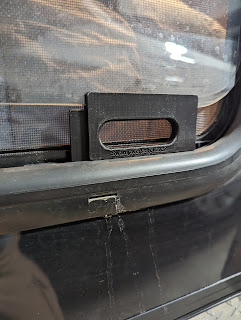As I've said before, this trailer has been a very agile project. There have been more than a few compromises, changes, and adjustments on the fly, and hey - in my defense, I've never done this before, and some of the 'rules of thumb' are an opportunity to insert your thumb between the board and the hammer!
In this case, I'd designed the trailer frame with a standard hitch receiver mounted on the tongue. If I'd thought about this just a little more carefully, I _might_ have calculated the weight of the rack, and the bikes and factored that extra 125lb into the calculation for axle placement - and moved the darn thing a few inches forward. As it was, my tongue weight was closer to 230lb with the trailer loaded, so 300 would be very much too much.
But that's all water under the bridge. Fast forward 10 months to now, and I realized that in order to bring bikes they'd either have to go on the roof of the car, or on the back of the trailer. I opted for the latter. Having acquired fairly decent CAD skills, I sat down and whipped out a very elegant folded piece of 1/4" steel, and sent that off to Send-Cut-Send. Nope, the drawing was not something they could work with, and from the sketch, the price would easily buy enough steel to rebuild the whole darn frame...
So back to the drawing board. I started looking at hitch bits on the internet, and realized that all I really needed was a simple plate that could be replicated 3 times, and a steel tube for the receiver. Twenty five minutes later, I sent the new drawing off to Send-Cut-Send and received a quote that was *much* more reasonable (and in line with my target.
A week later, I received my 3 plates in a plain brown wrapper - FedEx guy commented that he didn't think the dog could carry it (she loves to handle the 'last mile' for FedEx), and he was correct. A quick trip to CoreMark for a 36" chunk of 'receiver tube (2.5" sq tube, .25 wall), and I was on my way to the shop for the evening. A little filing to open up the hole in the plate, a fair bit of time with the flap wheel to clean everything, and then a quick trip to the MIG welder, and I was on my way. The welds look horrid if I judge them fairly, but there's more than enough to keep the plates from ever breaking loose - and all three plates would have to break loose before the tube could move. A little cleanup with the flap wheel, a good wash down with acetone, and a couple of coats of primer and it's ready to finish coat.
A signature of mine is that any major project I do contains one red component. I started this years ago building bike wheels, with one red spoke nipple, and even before that on sailboat repairs, using red nail polish to cover a screw head (usually in a bilge).
In this case, I went slightly overboard...
It's bolted to the frame with 4 grade 8 bolts, across both the rear and next cross tubes, and it's definitely solid. I need to re-check the tongue weight, but I think it took about 50lb off the tongue. It does make the trailer a little more 'lively' to pull - it was so dead solid, but still less so than many boats I've pulled over the years on factory trailers.
It'll probably be spring before I have a picture of everything - the trailer is in the garage, most likely for the winter, but I promise I'll post more pics to "Life in the Swamp" next spring, and any additional construction details here as they get done this winter. Yes, there are still at least 10 projects to be finished on the build before it hits my definition of 'done'.




























